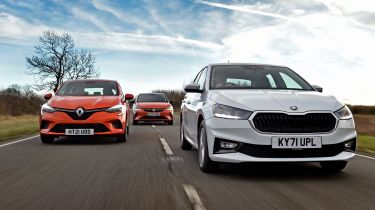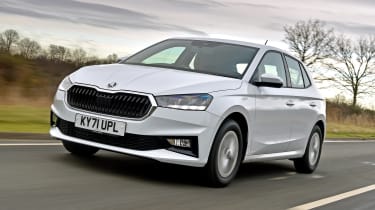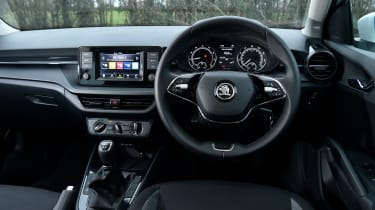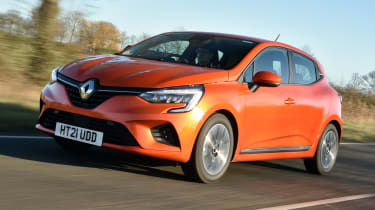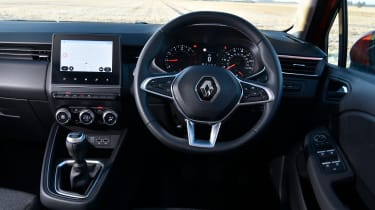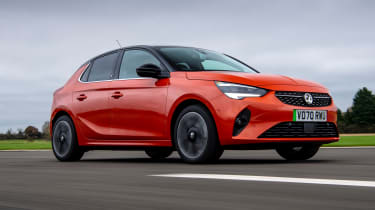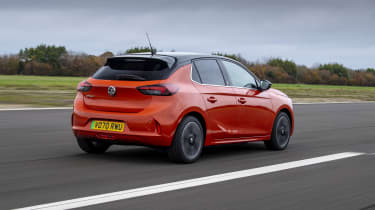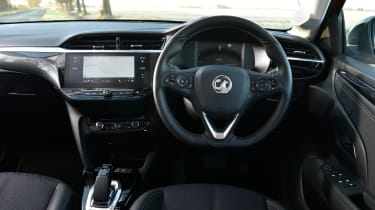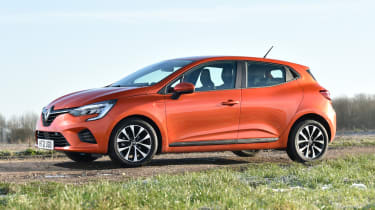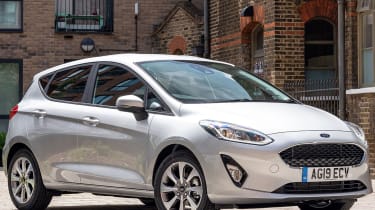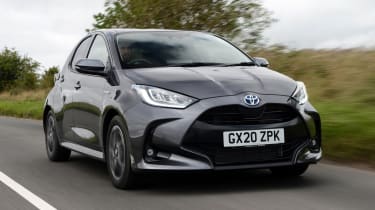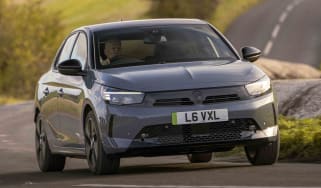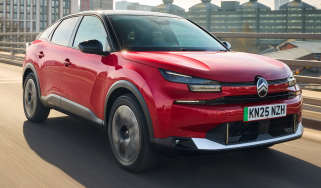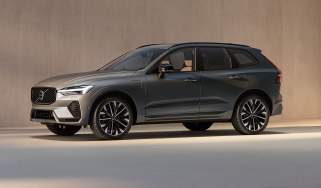Skoda Fabia vs Renault Clio vs Vauxhall Corsa-e: 2022 group test review
We put the new Skoda Fabia straight into the deep end by pitching it against the Renault Clio and Vauxhall Corsa-e
As you can imagine, we at Auto Express take our Car of the Year judging very seriously. Every year we test exhaustively the new metal on offer, dive into the figures and work out which car is deserving of a category win – and whether that earns it a place contending for the overall prize.
In our very first test of 2022, we’re looking at a car that might challenge for honours in the supermini segment:
the all-new Skoda Fabia. The company’s strengths across its whole range – space, refinement and value for money – are all qualities that align very closely with what buyers in this class look for most. In other words, if the new Fabia can lead the way in all three areas – most crucially when it comes to value – then we might be looking at a new class leader.
It won’t be an easy task, though, because we’re putting it up against the Renault Clio. The Clio has won our Supermini of the Year gong two years in a row, and the Fabia will need to be very special to topple it.
Just to throw a curveball into the equation, we’ve also lined up the Vauxhall Corsa-e. The electric version of Britain’s best-selling car is here to help us find out exactly how close we are to the tipping point between combustion and electric small cars when it comes to overall ownership costs – or if we’ve already passed it.
Skoda Fabia
| Model: | Skoda Fabia 1.0 TSI 95 SE Comfort |
| Price: | £17,745 |
| Engine: | 1.0-litre 3cyl turbo, 94bhp |
| 0-62mph: | 10.6 seconds |
| Test economy: | 48.9mpg/10.8mpl |
| CO2: | 155g/km |
| Annual road tax: | £155 |
We were very impressed with the Fabia on our first encounter late last year, testing a left-hand-drive version equipped with a 108bhp 1.0-litre petrol engine. The question is, will it remain as convincing in what will likely be its most popular form in the UK, a 94bhp model in mid-range SE Comfort trim? Before options, it’s priced from £17,745, which makes it the cheapest car here. The version you see in these images, with optional Moon White Metallic paint (£610), costs £18,355.
Used - available now

2021 Skoda
Fabia
30,022 milesManualPetrol1.0L
Cash £10,187
2019 Skoda
Fabia
25,704 milesManualPetrol1.0L
Cash £8,563
2018 Skoda
Fabia
89,000 milesManualDiesel1.4L
Cash £5,495
2021 Skoda
Fabia
30,214 milesAutomaticPetrol1.0L
Cash £13,649Design & engineering
At first glance, many people would struggle to tell the new Fabia apart from its predecessor. There are sharper creases and slimmer lights, but the overall look has maintained the supermini’s sensible and neatly proportioned shape. Yet while there isn’t much change on the outside, the body encloses a complete mechanical overhaul.
Gone is the old platform, replaced by the more advanced MQB-A0 layout used by the current Volkswagen Polo and SEAT Ibiza. This has helped Skoda’s engineers to give the firm’s newest model improved refinement, increased cabin space and more advanced safety and infotainment tech.
There was a time when the VW Group set the standard for perceived cabin quality in small cars, but lately it’s been Peugeot and Renault that have led the way. However, the Fabia runs that pair closer than anything else in the class. The quirky two-spoke steering wheel looks and feels as expensive as anything in the segment, and while this SE trim lacks the extra fabric dashboard highlights seen in higher-spec cars, the level of finish still feels solid. That feeling falls apart in the back, though; rear-seat passengers are left with door trims constructed almost entirely from the same panel of hard, unforgiving plastic. It still feels cheaper in the back than in the Renault.
For now, the Fabia’s engine range consists of four units, all based on a 1.0-litre three-cylinder layout. Two of them are turbocharged, producing 94bhp and 108bhp, while two of them aren’t, with 64bhp and 84bhp. This 94bhp version is expected to be the most popular option. While the most powerful motor has an extra 14bhp, it also has 200Nm of torque – but does this mean our test car is short on flexibility from its powertrain?
Driving
Comfort and refinement are the focus of the Fabia’s driving dynamics. The ride in particular is impressive for what is still a very compact car, with even broken surfaces proving to be soaked up well by the forgiving suspension set-up – as well as the chunky tyre sidewalls wrapped around the 15-inch wheels.
Beside the Clio, the major controls – the gearshift, the steering, the pedal weights – feel tighter and more solid, which gives the impression of a more secure, stable car. That is nothing more than an impression though; at speed, the Clio feels at least as secure, and settles onto its chosen course on a motorway just as effectively.
The Fabia’s 1.0-litre engine rarely makes its presence felt, getting the job done without being outstanding in any one area. It’s reasonably smooth, it’s quiet both at a cruise (at 70mph it’s pulling about 2,500rpm) and under hard acceleration, when it has more in-gear flexibility than the Renault’s unit.
Drivers looking for a fun supermini, however, should look elsewhere. The Fabia feels rather lethargic when turning into corners – although less so than the much heavier electric Corsa – and although the steering is well weighted, it doesn’t offer much feedback.
Practicality
The Fabia is the longest and tallest car in this test, and that translates into the most spacious cabin. It starts up
front, with a huge range of adjustment for the driving position, on both the seat and the steering wheel.
Moving into the back, there’s 976mm between the base of the seat to the roof, which means there’s 34mm more headroom than in the Clio. Knee room is also the best here, with space more comparable with a compact hatchback than a supermini. The one negative is that the central hump in the floor is the largest here; if you’ll regularly be carrying three passengers in the back, the Renault is a better option.
At 380 litres, the boot volume is very slightly down on the Clio’s, but the Skoda compensates with a host of useful, clever add-ons. These include an adjustable divider that clips into the side of the boot wall – ideal for holding small items that might otherwise roll around the floor – plus an additional lightweight shelf that sits between the floor and the parcel shelf. Those who carry drinks might be disappointed with the size of the cup-holders, though; they’re quite shallow, so careful driving is needed if you’re carrying a large coffee.
Ownership
When it comes to safety tech, autonomous emergency braking, lane keep assist and rear parking sensors are all included among the Fabia’s list of standard kit. Step up to SE L trim, and cruise control also features.
Both the Fabia and the Clio achieved a maximum five-star rating from safety body Euro NCAP. The Fabia’s category scores are lower than the Clio’s – it received Adult and Child Occupant protection ratings of 85 and 81 per cent respectively, compared with the Renault’s 96 and 89 per cent. But it’s worth bearing in mind that the Renault was tested in 2019, while the Skoda was tested according to more stringent standards in place in the latest 2021 scoring system.
However, the Corsa only achieved four stars in 2019. It chalked up lower scores than the directly comparable figures for the Renault in all four key categories.
Testers’ notes
“Skoda is known for its ‘Simply Clever’ features, but one example, the umbrella stored in the door, only comes with higher-spec Fabia trim levels.”
Renault Clio
| Model: | Renault Clio TCe 90 Iconic |
| Price: | £18,290 |
| Engine: | 1.0-litre 3cyl turbo, 89bhp |
| 0-62mph: | 12.2 seconds |
| Test economy: | 44.8mpg/9.9mpl |
| CO2: | 118g/km |
| Annual road tax: | £155 |
Our two-time Supermini of the Year has had a couple of minor spec tweaks to its engine since we last tried it, but prices still remain competitive. This Iconic model, the most basic in the Clio’s three-strong trim structure, is still generously equipped and starts from £18,290. Throw in the eye-catching Valencia Orange paint (£700) and a spare wheel (£300) and the total comes to £19,290.
Design & engineering
As with the new Fabia, Renault’s designers took an evolutionary approach to the current Clio’s styling, but the familiar shape in fact covered up some fairly significant mechanical changes.
Compared with its predecessor, this fifth-generation model uses an all-new platform, named CMF-B. It enabled Renault to not only improve interior packaging significantly, but also introduce better infotainment and safety tech. The suspension layout consists of MacPherson struts at the front and a torsion beam to the rear – pretty standard practice for the supermini class these days.
It also allowed Renault to install a hybrid powertrain, which the brand claims can cover up to 80 per cent of urban journeys in full-electric mode.
That’s one of two engine options, the second of which is tested here. It’s a 1.0-litre three-cylinder turbocharged unit, which following a recent update offers 10bhp less than the previous unit. The change means that overall output falls a little short of the Fabia’s powertrain to the tune of 5bhp. More significantly, 160Nm of torque is 15Nm down on the Skoda’s, while the Fabia’s maximum arrives at 1,600rpm compared with 3,750rpm for the Clio.
One of the Clio’s highlights is its cabin. Even in this fairly low-ranking Ionic trim, it feels rather plush for a supermini. The knurled effect on the climate controls and the little piano-style keys that sit above them lend a sense of occasion, which few rivals can compete with. Overall the fit and finish feel impressive, too.
Driving
The power difference between the Renault and Skoda is clear on paper, and it’s just as evident when you’re on the move – a 0-62mph time of 10.6 seconds for the Fabia is 1.6 seconds faster than the Clio’s. Overtakes need further forward planning in the Renault, and a downshift to fourth might be needed on sustained uphill motorway climbs when the Skoda will happily cruise along in fifth.
This means the Clio’s gearbox needs a little extra work, which only serves to highlight the fact that the Renault’s shift is baggier than the Skoda’s. The three-cylinder engine is fairly quiet for the most part, but under hard acceleration and at high revs – something that are needed more often due to its performance deficit – the engine can sound a little whiny.
Elsewhere, the Clio feels just as relaxing and refined as the Skoda in most areas, and both rank right at the top of the supermini segment in this regard, but the French car is also a little more fun. The Clio is much keener to turn into corners, and the tyres bite into the road better once the front end is loaded up.
Ride comfort is great in both cars, but the Renault’s soundproofing is marginally better at damping suspension knocks from the cabin. It’s a comfortable companion both around town and on longer journeys – especially when fitted with the fairly modest 16-inch alloy wheels that come with Iconic trim. Conversely, the Skoda’s body produces slightly less wind noise at motorway speeds.
There’s little to separate this bunch in terms of manoeuvrability or visibility. All three have an identical turning circle and each car offers a great view out, although the Corsa’s slightly larger C-pillars do affect over-the-shoulder visibility a little.
Practicality
At 391 litres, the Clio boasts one of the largest boots in the supermini segment, and it’s the largest of this trio. The space is deep and easily accessed, although in the case of our test car, some of that overall volume is occupied by an optional spare wheel. Beyond that, boot features don’t extend much further than a couple of bag hooks, but an optional reversible boot mat is a clever add-on that will come in handy for muddy boots or dog owners.
As with several of its rivals, the Clio is equipped with a third set of Isofix child seat mounts on the front passenger seat. This is handy for bulkier child carriers, which might otherwise be quite hard to wiggle through the fairly small back- door openings. Those doors feature handles that are integrated into the C-pillars. They lend the Clio a cleaner side profile, but might be a little trickier for children to operate.
Inside, the Clio scores well for cubby space – particularly its spacious doorbins and the enclosed storage between the front seats. The Skoda’s smartphone shelf is larger, though, and is available with an extra storage unit that extends the centre console towards the back seats. The Corsa is let down by a tiny glovebox.
Ownership
Renault has traditionally received rather disappointing feedback in our Driver Power customer satisfaction surveys, and a 20th-place finish in the manufacturer category (out of 29) continues that trend. However, its dealer network has seen an improvement over the past 12 months, achieving an above-average 10th spot for the 21 brands covered. Skoda received middling scores in both areas, taking 12th as a brand and 14th place for its sales and aftersales service.
Both firms beat Vauxhall, though. A 24th-place finish as a manufacturer buried it right towards the bottom of the pile, while its vast dealer network landed an equally poor 17th-place result.
Testers’ notes
“Auto locking is irritating. Get out of one door with the key on you and go to the other side, and the car will lock before you get there. It can be disabled, though.”
Vauxhall Corsa-e
| Model: | Vauxhall Corsa-e SE Premium |
| Price: | £25,805 |
| Engine: | 50kWh battery, e-motor, 134bhp |
| 0-62mph: | 7.6 seconds |
| Test economy: | 3.4mi/kWh |
| CO2: | 0g/km |
| Annual road tax: | £0 |
The debate about the cost benefits of electric vehicles has rumbled on – or should that be whirred away? – for some time. But recent price adjustments have made the Corsa-e more tempting. The car pictured here is a top-spec Elite Nav model, but we’re testing it in more affordable SE Premium spec. Before options – and after the Government’s recently reduced £1,500 Plug-in Car Grant – it comes to £25,805, which is £8,060 more than the Fabia. Can the savings made in everyday running costs offset the difference in purchase price?
Design & engineering
While EVs have become increasingly common at the higher end of the market, only a handful are available in
the supermini segment. Vauxhall offers buyers flexibility, so as well as this 134bhp electric model, it still offers petrol and diesel power, too.
On paper, it’s the Corsa-e that offers the most compelling figures – not only in the Corsa line-up, but also in this group; that power output is a full 40bhp clear of the Skoda’s, but it’s the peak torque figure of 260Nm that really catches the eye, because it’s also available from the moment you move away. However, some of that advantage is offset by the Corsa-e’s mass; the heavy 50kWh lithium-ion battery contributes to its 1,530kg kerbweight, which is 356kg more than the Clio’s and 388kg greater than the Fabia’s.
While it’s kitted out with the latest electric tech under the skin, from the outside the Corsa-e looks similar to its petrol and diesel counterparts. The same goes for the cabin; the Corsa-e gets a seven-inch digital driver’s display as standard (the combustion versions don’t) but otherwise the layout is identical. In this company, the design doesn’t quite look or feel as expensive as its rivals’, and the Clio’s softer materials on the dash are more pleasant to the touch than the Corsa-e’s hard surfaces.
For 2022, Vauxhall has introduced a couple of changes to make the Corsa-e operate more efficiently. These include lower-rolling-resistance tyres, an uprated heat pump to improve efficiency in colder weather and an optimised final-drive ratio for the motor to address one of our previous complaints – high energy consumption at motorway speeds. Officially, this means that the Corsa’s overall range has increased from 209 miles to 222 miles. The car in our test is a pre-update model.
Driving
You don’t have to travel far before the benefits of an electric drivetrain become apparent. The Corsa-e’s front-mounted motor allows the driver to meter out the power incredibly smoothly, making it an easy and relaxing car to drive in traffic. Save for the tiniest high-pitched whine, there’s almost no noise to accompany bursts of acceleration. It’s so smooth and quiet that it makes the petrol-powered cars here instantly feel old-fashioned.
And those fleet-footed jumps away from traffic lights and onto roundabouts are the occasions where most of the Corsa-e’s fun can be found. Put it into Sport mode, where the throttle response is at its sharpest, and the full 134bhp can be accessed, and the car really is a giggle to drive around town.
If you derive your fun from playful handling or feedback from the controls, though, there isn’t much pleasure to be had from the Corsa-e. On faster, more winding roads, the car’s weight becomes a little more obvious. While its low centre of gravity ensures stability, the Vauxhall still feels slower to turn into a corner than the other two, and the front tyres lose grip sooner as well. The steering doesn’t have any feel, which contributes to an overall impression of numbness.
These issues will matter little to most buyers, though. More of a consideration is the ride; across bumps that the Clio and Fabia shrug off without any fuss, the Corsa’s added mass means that it tends to bounce around more. It’s never harsh – and on a motorway it remains stable – but beside the other two, it can feel a little clumsy. We should point out that this isn’t all down to the electric powertrain, though; the Corsa as a whole is just a little less sophisticated to drive than many supermini rivals.
Practicality
It doesn’t matter which powertrain you choose for your Corsa – it’s fundamentally a less spacious supermini than either the Fabia or Clio. It’s most obvious in the back, where kneeroom is roughly 30mm down on the Skoda’s and marginally behind the Renault’s. Rear headroom is also the tightest of the bunch (again, only just behind the Clio), but on the plus side, the outer back seats are more sculpted than those in the Renault, and the seat bases are more supportive.
The lack of space is most apparent in the boot. The competition here each boast load spaces that are right at the top of the class, while the Corsa-e’s 267-litre volume is more than 100 litres behind both rivals. Things are slightly more impressive when the seats are folded; the Corsa-e’s 1,076-litre space is slightly up on the Renault’s, but still lags behind the 1,190-litre Skoda’s. The split rear bench doesn’t fold completely flat, either, and there’s a large step between the boot floor and the folded seat back.
Fitting a child seat isn’t the breeze that Clio and Fabia owners will find. The anchors are accessed through fiddly zipped slots; both rivals have wide plastic cases (the Clio’s covered by neat folding flaps), which make locating even the bulkiest of seats easy.
Ownership
The Corsa-e is supplied with a standard three-year/60,000-mile warranty. That’s the same as the Skoda’s, but less than the Renault’s five-year/100,000-mile package. However, the Vauxhall benefits from an eight-year warranty that covers the battery (and any potential degredation of the unit in that period). This is backed up by eight years’ breakdown cover – five years more than either of the other challengers.
Testers’ notes
“Piano-black trim looks great in the showroom, but we’re not convinced that shiny plastic will stay so bright once it’s exposed to the rigours of family life.”
Verdict
First place: Renault Clio
The Clio has faced off against its sternest test yet and passed with flying colours. In terms of refinement, it’s a close match for the Fabia, and although it’s down on power, it’s more fun to drive. But this result might have gone the other way if it weren’t for the Clio’s brilliant value for money. Despite the bargain price, it feels like one of the most expensive options in the class – and that makes it incredibly hard to beat.
Second place: Skoda Fabia
As an overall package, the new Fabia has the better of the Clio, but only just. It’s more powerful than the Renault, returns slightly better fuel economy, and is a little more spacious, particularly in the back. Those margins are very small, though, and in the budget-conscious supermini segment, value for money carries a lot of clout. For that reason, the Fabia can’t quite topple our favourite.
Third place: Vauxhall Corsa
We brought the Corsa-e along to find out whether now is the time that your wallet will thank you for switching to electric drive. Unless you’re a company car user, the answer is not yet, but that point is growing closer. With a slightly more impressive range and a lower price, the result could have been different. However, even with a combustion engine, the Corsa can’t quite compete with its rivals here.
Also consider...
- Model: Ford Fiesta 1.0 EcoBoost Titanium
- Price: £19,145
- Engine: 1.0-litre 3cyl, 99bhp
We’ve rated the Clio the most fun to drive of this trio, but the Fiesta still holds a clear lead for keen drivers. Brilliant handling doesn’t compromise comfort, and the punchy three- cylinder engine delivers great performance, too.
- Model: Toyota Yaris Icon
- Price: £20,210
- Engine: 1.5-litre 4cyl hybrid, 114bhp
If a full EV doesn’t quite suit yet, then the hybrid-powered Yaris makes a fine stepping stone. A remarkable 68.8mpg in WLTP tests shows the Yaris could be extremely cheap to run, and while it’s not as roomy as the Skoda, it’s more fun to drive.
Figures
| Renault Clio TCe 90 Iconic | Skoda Fabia 1.0 TSI SE Comfort | Vauxhall Corsa-e SE Premium | |
| On the road price/total as tested | £18,290/£19,290 | £17,745/£18,355 | £25,805/£30,110** |
| Residual value (after 3yrs/36,000) | £8,156/44.6% | £8,200/46.2% | £11,217/43.5% |
| Depreciation | £10,134 | £9,545 | £14,588 |
| Annual tax liability std/higher rate | £1,017/£2,033 | £981/£1,961 | £55/£109 |
| Annual fuel cost (12k/20k miles) | £1,772/£2,953 | £1,623/£2,705 | £607/£1,012 |
| Insurance group/quote/VED | 9/£379*/£155 | 10/£427/£155 | 24/£648/£0 |
| Service costs | £499 (3 years) | £456 (2 years) | £419 (3 years) |
| Length/wheelbase | 4,050/2,583mm | 4,108/2,552mm | 4,060/2,538mm |
| Height/width | 1,440/1,798mm | 1,479/1,780mm | 1,433/1,765mm |
| Engine/powertrain | 3cyl in-line/999cc | 3cyl in-line/999cc | E-motor/li-ion battery |
| Peak power/revs | 89/5,000 bhp/rpm | 94/5,000 bhp/rpm | 134bhp |
| Peak torque/revs | 160/3,750 Nm/rpm | 175/1,600 Nm/rpm | 260Nm |
| Transmission | 5-spd man/fwd | 5-spd man/fwd | Single-speed/fwd |
| Fuel tank capacity/spare wheel | 42 litres/£300 | 40 litres/£320+ | N/A/repair kit |
| Battery capacity/usable | N/A | N/A | 50/45.3kWh |
| Boot capacity (seats up/down) | 391/1,069 litres | 380/1,190 litres | 267/1,076 litres |
| Kerbweight/payload/towing weight | 1,174/527/900kg | 1,142/526/1,000kg | 1,530/386kg/N/A |
| Turning circle | 10.4 metres | 10.4 metres | 10.4 metres |
| Basic warranty (miles)/recovery | 5yrs (100,000)/3 yrs | 3 yrs (60,000)/3 yrs | 3 yrs (60,000)/8 yrs |
| Driver Power manufacturer/dealer pos | 20th/10th | 12th/14th | 24th/17th |
| NCAP: Adult/child/ped./assist/stars | 96/89/72/75/5 (’19) | 85/81/70/71/5 (’21) | 84/86/66/69/4 (’19) |
| 0-62mph/top speed | 12.2 secs/112mph | 10.6 secs/120mph | 7.4 secs/93mph |
| Auto Express econ (mpg/mpl)/range | 44.8/9.9/414 miles | 48.9/10.8/430 miles | 3.4mi/kWh/154 miles |
| WLTP economy (petrol) | 54.3mpg | 55.7mpg | N/A |
| WLTP range (EV) | N/A | N/A | 222 miles |
| Actual/claimed CO2/tax bracket | 146/118g/km/28% | 133/115g/km/28% | 0/0g/km/1% |
| Airbags/Isofix/park sensors/camera | Yes/yes/rear/no | Yes/yes/rear/no | Yes/yes/rear/no |
| Auto box/lane keep/blindspot/AEB | No/yes/no/yes | No/yes/no/yes | Yes/yes/no/yes |
| Climate control/cruise control | Yes/yes | Air-con/no | Yes/yes |
| Leather/heated seats | No/no | No/no | No/no |
| Metallic paint/LED lights | £700/yes | £610/yes | £700/yes |
| Keyless entry & go/power tailgate | Yes/no | No/no | Yes/no |
| Sat-nav/digital dashboard | Yes/yes | No/no | Yes/yes |
| DAB radio/connected services | Yes/yes | Yes/yes | Yes/yes |
| Wireless charge/CarPlay/Android Auto | £165/yes/yes | No/yes/yes | No/yes/yes |
